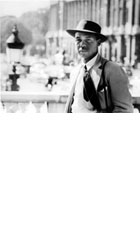
Ralph Ellison, An American Journey 2001
Distributed by California Newsreel, Order Dept., PO Box 2284, South Burlington, VT 05407; 877-811-7495 (toll free)
Produced by Avon Kirkland and New Images Productions, Inc.
Directed by Avon Kirkland, Dramatic Scenes: Elise Robertson
DVD, color, 87 min.
Sr. High - Adult
African American Studies, American Studies, Literature, Sociology, Writing
Date Entered: 06/18/2004
Reviewed by Beatrice R. Pulliam, M.S., Library & Information ScienceRalph Ellison, an American Journey, is an engagingly, rich documentary chronicling the life and artistic work of Ralph Waldo Ellison. The documentary begins with Lewis and Ida Ellison’s migration from Tennessee to Oklahoma shortly after it achieved statehood. Ellison was born in Oklahoma in 1914 and both the Ellison family and the family business flourished in a pre-segregated Oklahoma until the sudden death of Ellison’s father in 1917. The previously well-to-do Ellison family spiraled into an “invisible poverty” as narrator Andre Braugher recounts. Ellison, then 3 years old, would develop a stammer that would resurface in 1967 after a fire destroyed his summer home and the bulk of recent work on an unfinished second novel.
Braugher’s carefully placed narrations and black and white images of a very young Ellison reveal him to be a gifted young student and talented musician despite his impoverished surroundings. Walks with his brother and mother through wealthy white neighborhoods served as “glimpses of a better life” and would fuel Ellison’s dreams of becoming a renaissance man. Renaissance men were exemplified by the early jazz greats that frequented the thriving black enclave in the “Deep Deuce” section of Oklahoma City in the 1920s. Dramatizations of Ellison hopping a freight train to claim a music scholarship at Tuskegee Institute and additional images of Ellison in his early “Joe College” days portray him as a voracious reader mesmerized by the imagery in T.S. Eliot’s writings. Ellison’s creative interests quickly turned from music to modern fiction and writing but he would continue to make connections between the imagery in jazz music and writing throughout his life.
Ellison’s growth as a writer is fleshed out in recent interviews with such cultural luminaries such as Cornel West, Amiri Baraka, Terrence Rafferty and others. West and others discuss the significance of Ellison’s friendship with Langston Hughes and mentor Richard Wright and the several years’ work and life experience that culminated in the publication of Ellison’s seminal and best-selling novel Invisible Man in 1952. They also comment on the high standard set by Ellison in the character development of blacks in modern literature. Braugher describes Ellison’s writing as really revealing “the complexity and richness of everyday black life.” In an interview, Clyde Taylor, cultural historian and professor at NYU saw Ellison’s Invisible Man as the first to show that “any life can be given intense profound examination” and that Ellison could “do with black life, what Homer did for Greek life or Joyce did for Irish life.” Ellison’s alliance with what Braugher refers to as the “Eurocentric literary mainstream” and his penchant for characters that transcended their often, dire stations in a racist society (read not what popular black protest literature favored during this time), drew critics from white progressives. It also drew attention to the growing generational rift between Ellison and the Black Nationalists and the Black Arts Movement in the sixties and early seventies. In response to the growing Black Nationalist movement in the sixties, Ellison reportedly said “it was hard to hold a pen with a clenched fist.” Both West and Ellison critic Amiri Baraka share enlightening views on this contentious period in American history.
The documentary fast forwards through Ellison’s work as an educator, leaving us wondering. It would have been wonderful to hear from former students that encountered Ellison during this twenty year period. We’re left to speculate as to the relevance of his work as an educator in the later part of his career. The documentary quickly rebounds with Toni Morrison’s stirring reading of Ellison’s posthumously released second novel, Juneteenth, in 1999.
This is an extremely fascinating, intimate look at one of America’s most provocative writers of the Twentieth century. This documentary is a good starting point for further study and discussion among advanced high school and college students of American literature.